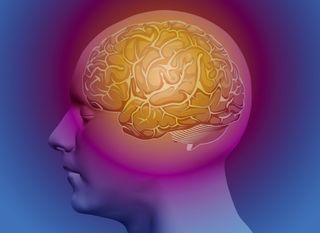Is There Such Thing as Mind Reading Computer?
Mind-Reading Computer Instantly Decodes People'due south Thoughts

A new computer programme tin can decode people's thoughts near in existent time, new enquiry shows.
Researchers can predict what people are seeing based on the electrical signals coming from electrodes implanted in their brain, and this decoding happens inside milliseconds of someone first seeing the image, the scientists found.
The new results could one mean solar day have applications for helping people, such as those who cannot speak or have trouble communicating, express their thoughts, Rajesh Rao, a neuroscientist at the University of Washington in Seattle, said in a statement. [10 Surprising Facts About the Brain]
"Clinically, you could recollect of our effect as a proof of concept toward edifice a communication mechanism for patients who are paralyzed or have had a stroke and are completely locked in," Rao said.
Reading thoughts
In contempo years, scientists take made tremendous strides in decoding homo thoughts. In a 2011 written report, researchers translated encephalon waves into the flick clips people were watching at the time. In 2014, two scientists transmitted thoughts to each other using a brain-to-brain link. And other studies have shown that computers can "see" what people are dreaming most, using only their brain activeness.
Rao and his colleagues wanted to meet if they could farther this effort. They asked seven people with severe epilepsy, who had already undergone surgery to implant electrodes into their temporal lobes, if they would mind having their thoughts decoded. (The patients had the electrodes implanted for a single week and so that doctors could pinpoint where the seizures originated within the temporal lobe, which is a common source of seizures, the researchers said.)
"They were going to get the electrodes no matter what; we were simply giving them additional tasks to exercise during their hospital stay while they are otherwise just waiting around," said report co-author Dr. Jeff Ojemann, a neurosurgeon at the University of Washington Medical Center in Seattle.
The temporal lobe is too the brain region responsible for processing sensory input, such as visualizing and recognizing objects that a person sees.
Rao, Ojemann and their colleagues had the participants lookout a computer screen as several images briefly flickered by. The images included pictures of faces and houses, likewise as bare screens, and the subjects were told to keep alert to identify the image of an upside-down business firm.
At the same time, the electrodes were hooked up to a powerful computer program that analyzed encephalon signals i,000 times a second, determining what brain signals looked like when someone was viewing a business firm versus a confront. For the first two-thirds of the images, the computer program got a label, essentially telling information technology, "This is what brain signals look like when someone views a house." For the remaining one-3rd of the pictures, the figurer was able to predict, with 96 percent accuracy, what the person actually saw, the researchers reported Jan. 21 in the journal PLOS Computational Biological science. What's more, the computer accomplished this chore within 20 milliseconds of the instant the person looked at the object.
Complex procedure
Information technology turned out that different neurons fired when people were looking at faces versus when they were looking at houses. It also turned out that the figurer needed two types of brain signals to decode the images: an issue-related potential and a broadband spectral change. The event-related potential is a characteristic spike in encephalon cell firing that appears when the encephalon responds to any stimulus, whereas the broadband spectral modify is detected past electrodes as an overall change in power across the brain region.
"Traditionally, scientists have looked at single neurons," Rao said. "Our report gives a more global picture, at the level of very large networks of neurons, of how a person who is awake and paying attention perceives a complex visual object."
By allowing researchers to identify, in real time, which parts of the brain respond to certain stimuli, the new technique could help doctors map the entire human brain ane day, the researchers said.
Follow Tia Ghose on Twitter and Google+ .FollowLive Science @livescience , Facebook& Google+ . Original article on Live Science.
Source: https://www.livescience.com/53535-computer-reads-thoughts-instantaneously.html

0 Response to "Is There Such Thing as Mind Reading Computer?"
Post a Comment